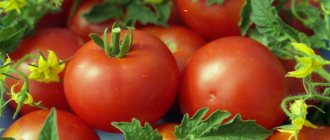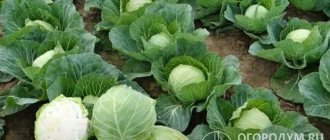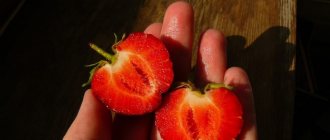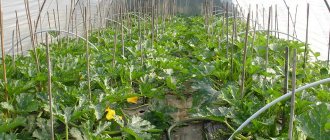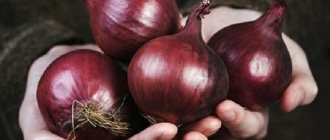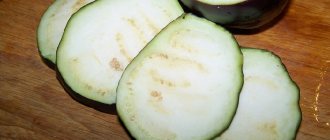Domestic gardeners did not remain indifferent to the success of Czech breeders - the Maryshka strawberry. This variety has earned a reputation as one of the most productive and tasty among large-fruited varieties of crops, well suited for cultivation on personal plots.
Strawberry Maryshka (pictured) is distinguished by the rapid ripening of large berries that have an original shape and a pronounced strawberry taste
In reviews, the variety is described as unpretentious and stable when cultivated in open ground in the central regions of Russia, as well as in Ukraine and Belarus, but is considered unsuitable for the harsh and moderate continental climate of Siberia and the Urals.
Information about “Maryshka” appeared on the Internet about 10 years ago. There is a possibility that in the Czech Republic itself the variety is called differently, so it is impossible to identify it by the Russian version of the name.
Description of the variety
Strawberry Maryshka has earned positive reviews from gardeners. Suitable for the climate of the southern and central regions of Russia, Ukraine, Belarus. In Siberia and the Urals, cultivation in greenhouses is possible.
Bushes
The bushes are powerful, vigorous, densely leafy. The leaves are small and shiny. Peduncles rise above the foliage and lie dormant during the period of fruit ripening. The flowers are small, white, bisexual. Thanks to the multi-flowered structure of the peduncles, more than 50 berries can be collected from one plant per season. The number of peduncles is large: one-year-olds have 4-5, two-year-olds have more than 10-15. The adaptability is very high, the stolons are long and thin.
Garden strawberry Maryshka is distinguished by a branched root system, which allows the variety to survive in extreme situations
Berries
Maryshka berries are generally uniform in size. The average weight of the first fruits is 30 g, sometimes 60 g due to the phenomenon of fasciation, when several flowers grow together. However, the variety produces few such fancy berries. The shape of the fruit is wide, flattened, rectangular, or elongated, similar to “fingers”. Variations in shape depend on climatic conditions. Ripe strawberries acquire a red color with a burgundy tint and a glossy shine. The yellow-green seeds are concentrated closer to the nose and are located above the surface of the skin, which gives the impression that there are more of them than on other varieties.
The undoubted advantage of Maryshka is its taste - very sweet, with a rich strawberry aroma, without any acid at all. Professional tasters rate this indicator at 4.8 points out of 5 possible. The variety is sweet even in a state of technical maturity. The structure of the fruit is loose and dry.
In some reviews from gardeners, there is a definition such as “sickly sweet taste.” For children, Maryshka is a garden candy
Productivity
The variety belongs to the mid-early, single-bearing varieties. The yield of the harvest is friendly - 10-14 days. The average productivity of the variety is 0.5 kg. from the bush. According to gardeners, if you pay increased attention to strawberries, you can harvest higher yields.
Transportation and storage of the harvest is possible, but the berries cannot be frozen; they will turn into a jelly-like mass.
a brief description of
It is difficult for Maryshka to compete with high-yielding large-fruited varieties. But she has many fans for her merits.
Advantages of the variety
- excellent taste characteristics;
- gains sugar content in any weather;
- the fruits are not baked in the sun;
- high drought resistance;
- a strong root system allows the bushes not to wither during drought;
- ease of reproduction;
- loose pulp, “not like a cucumber,” which is typical of many modern varieties;
- self-pollinating, does not require pollinating neighbors;
- the possibility of obtaining an early harvest when grown in a greenhouse;
- good transportability;
- high resistance to ticks;
- high immunity to diseases.
Disadvantages of the variety
- tendency to form a large number of mustaches;
- the berries become smaller towards the end of the harvest;
- average yields;
- does not apply to large-fruited ones.
These shortcomings are offset by its delicious taste and low maintenance requirements.
Landing
It is best to plant seedlings at the end of July so that they have time to take root well and develop before frost. In this case, next year you can get a 100% return on yield. Spring planting is also possible, but the bush will not reach its potential in the first year.
The little mouse prefers flat areas, well lit by the sun, protected from northern winds by buildings. Like any garden strawberry, it loves fertile soil with neutral acidity (optimally pH 5.2-5.5), at the same time it can adapt to any soil structure.
Recommended planting pattern:
- 30-40 cm between bushes;
- 40-60 cm between rows.
The plantings should not be thickened, since the assortment produces powerful, densely leafed bushes, and maintenance will be difficult.
The land for planting is prepared in advance: for spring planting - in the fall. The soil is dug up, a bucket of rotted manure or compost and a glass of wood ash are added to each m2. If the soil is acidic, deoxidize it with lime or dolomite flour (400 g/m2).
Growing and care
The Maryshka variety belongs to the “plant and forget” category; the bushes will not disappear. But if you carry out minimal care, which consists of watering, weeding and normalizing the shoots, the result will be much better.
Watering
Despite its heat resistance, Maryshka loves water. During the period of flowering and fruit set, you need to provide strawberries with watering at least 2 times a week. A few days before harvesting, watering is stopped, so the fruits will be sweeter and more aromatic.
Garden strawberries Maryshka begin to bear fruit about a week later than the Tsaritsa variety.
Loosening, weed control
Loosening the soil on the second day after watering has a beneficial effect on the development of strawberries and prevents weeds from growing in the garden. Moisture at the roots is retained longer if there is no crust on the surface of the soil with cracks through which water evaporates. Mulching the beds serves the same purposes as loosening. Sawdust, straw, peat, pine needles or black non-woven material are used as mulch.
Removing a mustache
The mustache is left only on those bushes that are planned to be propagated. In other cases, they need to be removed so that the bed does not become overgrown and the fruits do not become smaller. Removal is done with a sharp pruner or knife.
Top dressing
Compost, cow manure, and bird droppings are suitable for feeding Maryshka. The main thing is to maintain moderation. If there is an excess of fertilizers, the fruits will not be as tasty. However, if the soil is poor, the yield decreases and the berries become smaller.
Fertilizing is applied in the spring, before flowering and at the end of fruiting, to restore the soil composition and enable strawberries to lay strong flower stalks for next year's harvest.
- In spring, fertilizers with a high nitrogen content are used. This can be a solution of mullein (1:10), bird droppings (1:20), urea or a complex composition with the code name “Spring”.
- Before and at the height of flowering, complex formulations are used, which are applied under the roots and along the leaves. Approximate dosage is 10-15 g per 10 liters. water.
- In autumn, a complex fertilizer with a high content of potassium and phosphorus is used. Such fertilizers are often sold under the name “Autumn”.
In autumn, nitrogen fertilizers should not be applied so as not to provoke vegetation in the plant.
Pest and disease control
The marmoset has excellent immunity. It is very rarely affected by diseases and pests. Even in the most unfavorable seasons it will survive where many other varieties will die.
Disease prevention will include cleaning the beds of weeds and removing excess mustache. You can plant plants next to strawberries that produce phytoncides - garlic, calendula, marigolds.
If Maryshka is grown in a greenhouse, good air exchange must be ensured so as not to provoke the development of root rot.
Preparing for winter
For the winter, strawberry bushes must be covered with a layer of straw, compost, and spruce branches. You can put low arcs on which to stretch agrofabric. The variety is frost-resistant; in the southern regions there is no need to cover the beds.
How to care
Watering
At first, the planted plants need regular watering. Moreover, it is worth using the sprinkling method for this. Approximately 2-3 liters of water will be needed per 1 m2. After 7 days, when the seedlings have taken root, watering can occur once every 6-7 days. This information will help you understand how to water the Jolie strawberry variety, as well as how to properly feed these varieties of berries.
Fertilizing
To feed garden strawberries, you can use mineral compounds, bird droppings, ash, compost and humus. Fertilizing should be done when the growing season begins.
But you need to be careful with the amount of fertilizers, since their abundance has a negative effect on the fruits. They become tasteless and may begin to rot. The application of nitrogen fertilizers is considered especially harmful. But with their shortage, the fruits become smaller, lose their sweetness, and the bushes themselves change the color of the leaves.
There is no need to fertilize for several years after planting if the soil has been fertilized before. It is necessary to apply phosphorus-potassium mixture in the spring of the second year of cultivation. They can simply be scattered over the area in an even layer. Granular fertilizers are still useful for the soil. Distribute them evenly between rows in moist furrows. And here you can learn more about the necessary fertilizing for the Darenka strawberry variety.
Fighting diseases
Sometimes, even with careful care, you may find that the bushes begin to hurt. If the disease is not eliminated in a timely manner, you may lose the entire harvest. Red root rot is very dangerous for berry bushes.
It can form if the landing site is chosen incorrectly. This disease manifests itself in damp and unlit soil. Affected roots prevent the plant from developing normally. It is very easy to detect an infected bush. The foliage begins to turn yellow and dry out. The roots become dark. It is also worth familiarizing yourself with the Vima Tarda strawberry variety, and understanding what pests are most often found in this berry variety, and how to deal with them.
Svetlana, 56 years old: “The Maryshka variety has been bearing fruit for me for the 5th year already. During this time I did not have any complaints about him. I really like ripe and huge berries. I use them for sale. The harvested crop can be stored in the refrigerator for a long time without losing its presentation. At first, I only had one bed planted with strawberries, but after 2 years I was able to increase the area of plantings. And all this is due to the fact that the bushes produce quite a lot of tendrils.” Tatyana, 31 years old: “The little monkey on my plot bore fruit for about 4 years, but then, due to my stupidity, the bushes began to disappear
And this is due to the increased importance on the site. One summer there were heavy rains. And due to severe waterlogging, the plants suffered root rot
There are only 8 bushes left from the entire garden bed. Now I am actively propagating this variety, but now I have provided drainage before planting. Even during drought, I water the bushes once a week. I don’t use mulch, but I do fertilize regularly – 3-4 times a season.”
And due to severe waterlogging, the plants suffered root rot. There are only 8 bushes left from the entire garden bed. Now I am actively propagating this variety, but now I have provided drainage before planting. Even during drought, I water the bushes once a week. I don’t use mulch, but I do fertilize regularly – 3-4 times a season.”
It is also worth checking out the information about reviews of Arosa strawberries.
Maryshka is a variety of strawberry that differs from others due to its large size, excellent taste and long shelf life. And the collected berries are excellent for both processing and fresh consumption.
This is interesting: Strawberry Mashenka
Reproduction
The mouse can be propagated in three ways:
- Seeds. Sowing is done at the end of February in containers. Seedlings dive after the appearance of two true leaves. Planted in open ground when the threat of frost has passed.
- Dividing the bush. The branched root system allows you to divide an adult plant into 3-4 full-fledged seedlings, which are immediately planted in a permanent place.
- Usami. With this method, Maryshka will do everything herself. The plant only needs to provide space for the rosettes to take root and water them regularly.
The last method is the least labor-intensive and fastest. To obtain a productive bed, it is advisable to renew the plantation once every 3-4 years.
Types of Strawberries
- Repairers. These varieties can be harvested several times a year. The first fruit harvest begins around June, depending on the climate. The last harvest is the richest and is concentrated in early September.
- Large-fruited. Thanks to it, strawberries produce an excellent harvest of large sizes, which is characterized by a sour taste.
- Early. Harvest in late May, early summer.
- Mid-season. They bear fruit in mid-summer.
- Late. The harvest ripens in the first days of September.
Reviews
I call Maryshka berries “sweet fingers”, they are long and thin, only the first berries are large, similar to a matchbox. The berry has an incomparable taste, dry, very sweet, sourness is not felt at all. In my opinion, it is Maryshka that is most similar to wild strawberries. It produces a lot of whiskers, so there are no problems with reproduction.
I finally found out what kind of variety is growing on my plot. In the nursery, the marmoset is called both Bounty and Bogota, or they are mistaken, or it is a marketing ploy to sell the old variety under a new fashionable name. I lost it to Asia, Syria and Malling Century and was removed from the site.
Strawberry Maryshka will delight the gardener with sweet berries even in the most unfavorable season. Many large-fruited and productive varieties cannot compare with it in taste and aroma, but mediocre yield and small fruit do not allow Maryshka to be considered a competitor to the modern promising assortment.
Video
We invite you to watch the presentation of the “Maryshka” variety and get advice from an experienced gardener on growing large-fruited strawberry varieties in the following videos:
About the author:
His main specialty is an accountant, so even at his dacha he strives for accuracy and achieving ideal order in everything. Preference is given to growing grapes. I am sure that the deeper you delve into gardening and gardening, the more you understand that there is no limit to perfection!
Found a mistake? Select the text with the mouse and click:
Ctrl + Enter
Do you know that:
It is believed that some vegetables and fruits (cucumbers, stem celery, all varieties of cabbage, peppers, apples) have “negative calorie content,” that is, more calories are consumed during digestion than they contain. In fact, only 10-20% of the calories received from food are consumed in the digestive process.


